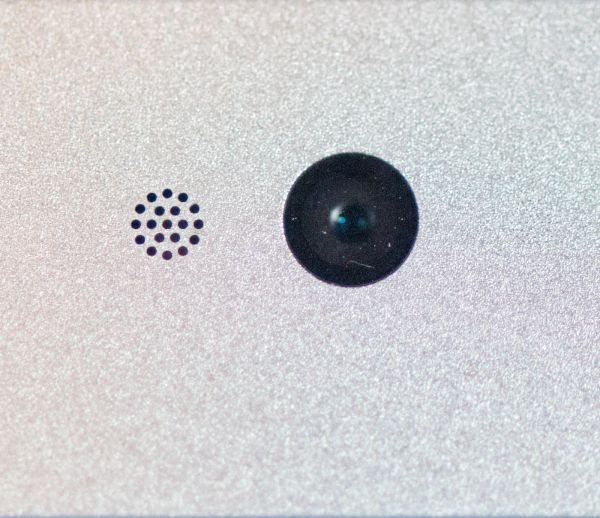The MacBook Pro Review (13 & 15-inch): 2011 Brings Sandy Bridge
by Anand Lal Shimpi, Brian Klug & Vivek Gowri on March 10, 2011 4:17 PM EST- Posted in
- Laptops
- Mac
- Apple
- Intel
- MacBook Pro
- Sandy Bridge
FaceTime HD Cameras
One of the more subtle changes between the 2010 and 2011 MBPs (and other MacBooks) is the departure from strictly VGA "iSight" cameras. The new FaceTime HD cameras are 1280x720, though Photo Booth oddly still only captures at just VGA.
A quick run to the command line and use of isightcapture enables true native resolution capture at 1280x720 until Photo Booth gets updated (if ever). I propped a 2011, 2010, and 2006 MBP up inside my lightbox and setup the scene I usually use for smartphones, and tossed in a GMB color checker card. I took photos from the command line at full resolution with no compression with both tons of light from a huge CCFL, and again with very little light. You can immediately see how things have changed if you check out the gallery with those uncompressed photos at native resolution.
The 2011 MBP's optical system achieves almost the exact same magnification (eg the height of the test objects remains the same if you scale vertical resolution) as the 2010 model. You just get a wider image at higher resolution. It isn't perfect, and even with gobs of light there's noise visible, but the quality is dramatically better. White balance is changed, with the old 2010 model having a slightly reddish cast. The difference is easily discernible in the color checker card. The old model also had less than perfect exposure (the light part at the right of the cup is completely saturated) compared to the new. Dark performance is also slightly better, again with a different color cast.
Visually, I was hard pressed to notice anything different between the two cameras on the outside. The older 2010 MBP seems to have a larger aperture, subjectively, which seems the opposite of how I'd expect things to go.


Left: 2010 MBP, Right: 2011 MBP
The other part of the story is of course FaceTime HD itself, which ups the quality of FaceTime sent from the 2011 MBP from 320x240 to 720P. While the new MacBook Pros ship with FaceTime preinstalled, older Macs need to purchase it from the App Store for $0.99. FaceTime HD leverages Sandy Bridge's Quick Sync for encoding 720P, although as we pointed out earlier—CPU utilization is still quite high. While only 2011 MBPs can send HD FaceTime, there are also restrictions on what Macs have enough processing power to decode it.

FaceTime HD works pretty well. The application starts in a small portrait window but is both scalable and viewable in landscape as well.
There's no support for text communication during a FaceTime HD chat, just video. The video quality scales dynamically with available bandwidth. FaceTime HD worked over a 512Kbps upstream connection but had reduced quality compared to transmitting over a 2Mbps connection.


















198 Comments
View All Comments
iwod - Friday, March 11, 2011 - link
iPad is only just starting to sell and iPhone still has lots of space to grow. The trend is Apple are making more units and more money from ARM specific products.Nvidia has just recently stated that Project Denver will be ARM 64 bit. And aiming at HPC and Desktop. Full Compatible with current ARM instruction set.
Currently Apple must have a ARM version of Lion testing, and few years down the road, they could switch their Mac over to ARM 64 bit. Using a single Instructions Set for their whole product line.
For some reason i have been thinking that Apple and Intel aren't doing too well together like anand has felt. I dont think Thunderbolt is any indication of their current relationship. it is merely they have been working on it for such a long time, no one wants to lose our at the end.
Of coz it could have been the other way round x86 moving into iPhone, although that depends how much intel is willing to bend towards apple.
jbh129 - Friday, March 11, 2011 - link
Anand,Can you guys run your high-end 15 through the Windoze tests that were used on the 13?
Thanks
tajmahal42 - Friday, March 11, 2011 - link
Hello guys!First, I have to say this review is really awesome, as usual! Just what I was hoping for. The thoroughness and practical sense of your reviews continues to amaze me every single time.
For the 13" MBP, you mention "bouts of instability". Can you elaborate on that? Stuttering? Crashes? In what way do you notice that instability? I'm a little concerned now.
tno - Friday, March 11, 2011 - link
+1alent1234 - Friday, March 11, 2011 - link
my wife has been bugging me about our wifi since we moved and get a poor signal in a lot of the new apartment. told her i can get a new router with 3 antennas but we will also need a new laptop as well with the antennas to take advantage of it.which brings me to my question. i know the 15" model has the 3 antennas. does the 13" do MIMO as well?
tipoo - Friday, March 11, 2011 - link
They all use the new card.By the way, have you tried switching wifi channels, or installing DD-WRT and boosting signal? Even so, you don't need a new laptop after getting a new router if signal strength was the only problem.
alent1234 - Friday, March 11, 2011 - link
i'll try that, thxa lot of wifi around me these days. we only have work laptops now so that would be our only personal computer if we bought one. i was looking for the cheap SB models when they come out
name99 - Friday, March 11, 2011 - link
"told her i can get a new router with 3 antennas but we will also need a new laptop as well with the antennas to take advantage of it."This is not completely true. A base station with multiple antennas CAN do the equivalent of phase-array beam steering to direct most of the output power towards the target laptop. The laptop will thus see a stronger signal, and one of the better modulation schemes (eg 64-QAM 5/6) can be used rather than one of the weaker schemes. Thus your laptop, even if it has only one (or two) antennas can still see better performance.
Note, this is a theoretical possibility. I do not know the current state of the art in how well base stations utilize the various forms of transmit diversity that are available. And no review ever seems to talk about this stuff, either by testing how well the kit works with a single antenna device, or by talking to the manufacturer about what's in their product.
Brian Klug - Friday, March 11, 2011 - link
The 13" does have 3x3 MIMO as well, the exact same broadcom solution as the 15" I tested extensively.-Brian
7Enigma - Friday, March 11, 2011 - link
Anand and crew,I am very disappointed with the battery life numbers in this review. This is the first review of a laptop where it appears you have used a 3rd party app (Cody Krieger's gfxCardStatus tool) to significantly inflate the numbers of the new 2011 systems. 35-60% by your own numbers back on the discrete GPU battery life page, which you then fail to report in the battery life tables later on!
When you are tasked to review a system (especially an Apple product I might add) it should be reviewed as is, with no tweaking or 3rd party add-ons to boost performance/benchmarks. When have you EVER installed an add-on for a Windows-based laptop to improve performance/life? I can't think of one.
At best this was a simple oversight where you have benchmark numbers WITHOUT the gfxcardstatus, at worst this was a cover-up job which I have always argued in the forums against and on your site's behalf.
Please update the tables to show what a stock newly-purchased laptop at the Mac Store would deliver.
I am very disappointed in this coverage.